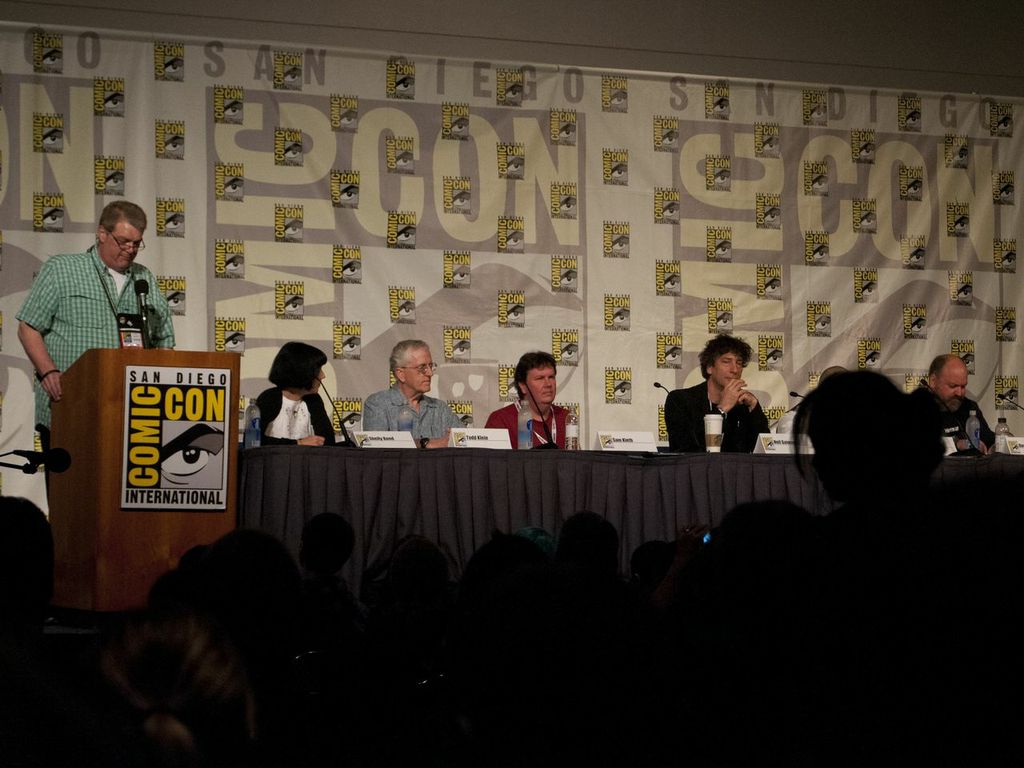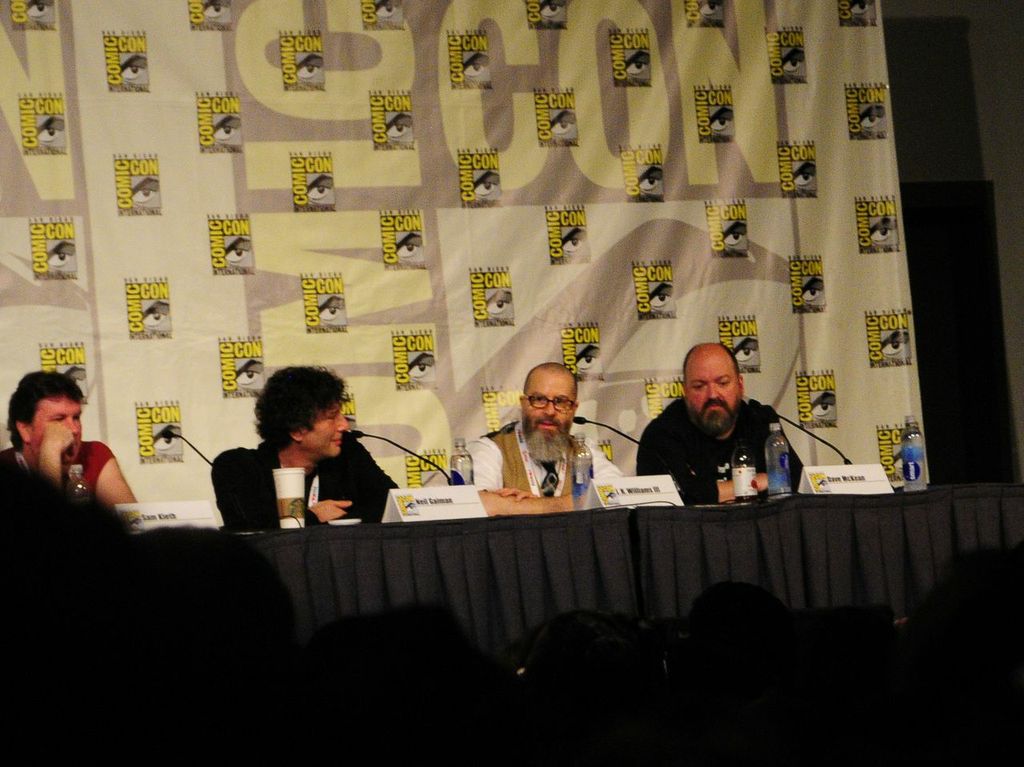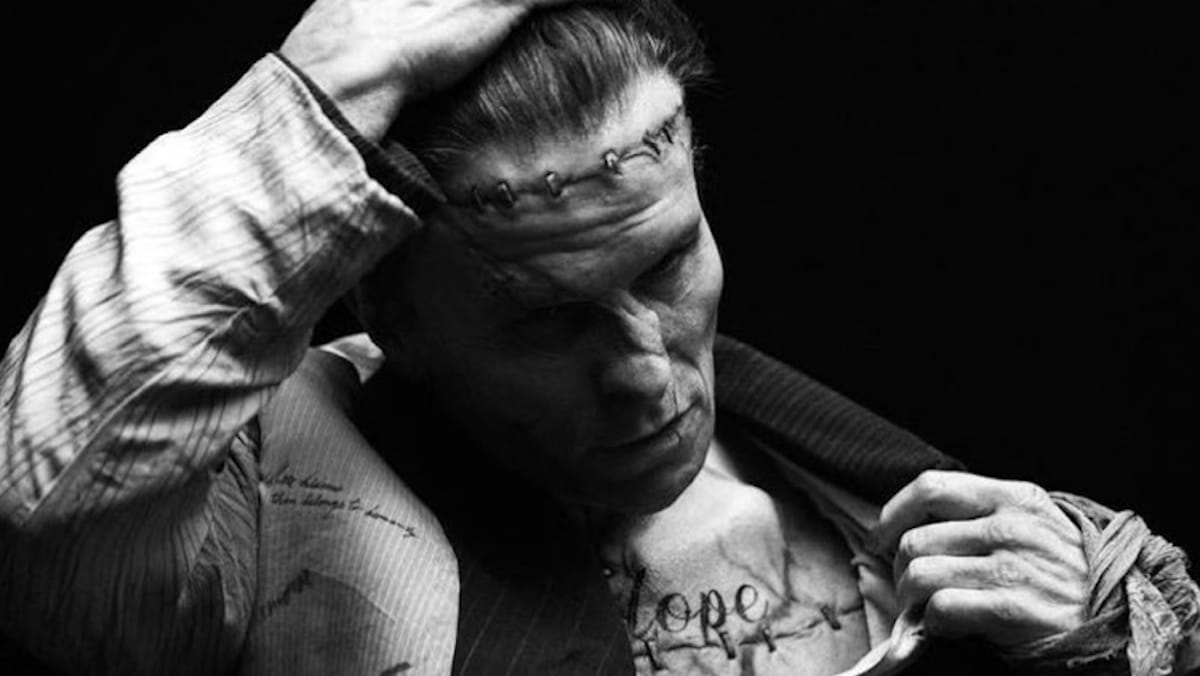By Nicholas Eskey
Almost 25 years ago, a comic book that really didn’t look, read, or follow the other hero laden stories that were more in circulation hit local store shelves. Its main character didn’t look like any of the flying, spandex wearing beings that saved damsels in distress and diverted near-world-apocalypses. In January of 1989, DC comics under the imprint of Vertigo, introduced the world to Neil Gaiman’s Sandman.
Located in room 6DE of the San Diego Convention Center, DC comics and Vertigo brought together a brilliant collection of people who worked on the comic. In attendance was Shelly Bond (editor during the comic), artists Todd Klein, Sam Kieth, Dave McKean, and JH Williams III, and of course Neil Gaiman himself (who I might add is a classy man with a stylish hairdo). The collective discussed the humble beginnings of the Sandman series, its better known issues and artwork, to even the series’ future.
Once the entire panel had been seated and said their introductions, we were shown on the big projector screen next to the proctor’s podium a house ad for DC comics from 1988. It showed the main character of Sandman (Morpheus) who fans would come to know eventually, holding in an outstretched hand a small pile of golden sand, his eyes glowing red. The words “Sandman” emblazoned below, with the tagline “He controls your dreams.” In big bold lettering off to the side the caption read, “I will show you Terror in a handful of dust.”
“Originally I used ‘I will show you Fear in a handful of dust,’ a quote from T.S. Eliot,” said Mr. Gaiman. “I got a call from DC who asked if it really was a quote, and I said yes. Then they said it needed to be changed then just in case T.S. Eliot’s estate would want compensation. So ‘fear’ became ‘terror.'”
Just before the idea of Sandman as we know and love came to be, Neil Gaiman was one of the writers working on Black Orchid #3. But, it was decided by a representative of DC that since he was a relative unknown at the time, to raise his profile and benefit the eventual release of Black Orchid, Neil Gaiman would start doing a monthly comic.
He came up with idea after idea, until his vision of reinventing Sandman (which was a comic done by Jack Kirby and Ernie Chua between 1974 and 76) won out. Instead of using the original character of Sandman who was named “Wesley Dodds,” Mr. Gaiman would create a whole new character. A god of sleep. And so, his first monthly published comic came to be.
“I felt I need[ed] something I can go anywhere with. A vehicle, a machine.” And with this proposed Sandman, he felt that it was just the vehicle he needed that could take him places that no other comic would or could go in terms of subject matter.
As the panel talks on, it is revealed where the whole design of the character of Morpheus came from. “I didn’t want to go in the direction of ‘Super Hero…’ I will make him look like a rockstar!” said Gaiman. Which he ended up looking very Bono-Bowie. “We said ‘who can draw this thing?'” he continued. “That’s where Sam’s name came up.”
Sam Kieth is the man who is credited for designing the look of Morpheus (The god of Dreams) which was eventually settled on, and has been used for all 75 issues of the comic’s series.
The panel then shifted focus, showing covers of various popular Sandman issues, and discussing them more in depth; starting with the very first nostalgic issue, to the very last. Each with a different story to call its own. Two of which I found personally interesting were the one’s entitled “Midsummer Night’s Dream” and the “Tempest” (which was also the last issue for Sandman). Somewhere along the way Neil Gaiman began to use William Shakespeare as a semi-reoccurring character. Personally inspired by this, the writer decided that Midsummer and Tempest needed to become issue titles, as they were the only two original, not borrowed plots used in Shakespeare’s plays.
Then in great fashion, to end the panel in wonderful fashion, a great announcement was made in regards to the future of Sandman and the character Morpheus. “Some stories I had written just never fit in the series.” revealed Mr. Gaiman. “At Sandman’s 20th anniversary, I came to DC with the idea of using them for a comic.” Sadly, the one’s at the helm at the time didn’t see fit to run with the stories, and they were left aside.
Nearing the 25th anniversary however, a new set of helmsman approached Mr. Gaiman and asked if he had anything special in mind. The stories he had set aside resurfaced. And hence the coming of what is to be known as Sandman Overture. It will deal with the story of how Morpheus before the original Sandman comic got mixed up in a battle on another world, and then later in a weakened state came to be captured in Sandman issue #1.
For any and all Sandman or story driven comic fans, the beautiful artistry that has been placed into this new series will wonder, astound, and awe. Much like the original series did of course. Be on the lookout for Sandman Overture, coming this year in October.










I didn’t get to this panel, but I did make it to the “Eisner and the Graphic Novel” panel, on which Mr. Gaiman sat as well. And yes, he is a classy man. (I rock a mean, 70s vice cop afro complete with ‘burns myself, so I scoff at his coif.)
And to be THAT guy, but you are referring to Dave McKean above, right? I THINK that’s his name I’m reading in the picture?
That’s the one! I’ve corrected the spelling, apologies!
Vertigo didn’t exist in 1988, Jack Kirby created the Sandman waaay before the 1970s series, and Black Orchid #3? Its obvious youre referring to the Gaiman/McKean prestige series but, I mean, come on.
This is pretty sloppy reporting, Nick.
As noted, Vertigo didn’t exist in 1988; it was created in 1993 as an umbrella for the already existing supernatural horror “comics for adults” titles at DC (plus Doom Patrol) and as a collective for the titles coming from Art Young’s failed Touchmark imprint for Disney. The first Vertigo Sandman was #47.
This isn’t just a nitpick. Sandman, especially in its first year, fit comfortably in the midst of these titles, with extensive allusions to and guest-appearances from DC universe characters (Dr. Destiny, the JLA and JSA, Infinity, Inc., and on and on). In fact, Wanda’s reference to “Weirdzos” in “A Game of You” exists because Mike Carlin, then-editor of the Superman titles, wouldn’t allow a DC-universe character make a reference to “the Bizarros”.
Sandman is a great comic, brilliant in parts and consistently extremely good. But it was evolutionary, not revolutionary, and it serves comics history poorly to treat it as if it came unfathered from Zeus’ brow.
They didn’t run with the stories he’d developed for the 20th anniversary? What are they, crazy? That’s just insane. When the (arguably) best writer in comics wants to make a new chapter in a hit series, you say yes.
To respond to those that commented on the “sloppy reporting.” I used what was said from the various panel people. Any and all facts, if they are incorrect facts, I apologize. I went by what was reported and what I heard.
“I didn’t fact check my story” isn’t exactly a legitimate defense. I expect journalism from this site, not stenography.
Don’t blame it on Nick – he was reporting the panel word-for-word as the panellists described it. He did a great job transcribing. I edited this piece, and ran it, so if you’re going to nitpick then do so to me, rather than him!
Steve – my comments and others above
Nick – you’re absolved of all blame! :)
It’s only because this site is so GOOD and I hold the Beat up to a real journalistic standard that I’m “nitpicking”.
Not to fan the flames, but I’ve got to agree with Moishe in the above comments.
I’m just now catching up on SDCC news by running through all of the posts on The Beat. Its been my favorite source for comics news for years and a regular visit when time better allows. So to have a story like this without any fact checking damages that usefulness. Paraphrasing, not transcribing as you suggest, comments made at a panel isn’t the kind of responsible reporting I’ve come to expect from the site or that makes it newsblog I suggest to others.
The coverage of SDCC has been very good so far, but this article makes me wonder else might’ve been reported wrongly. Is it too much to ask for some corrections to the text now that they’ve been noted in the comments?
Comments are closed.